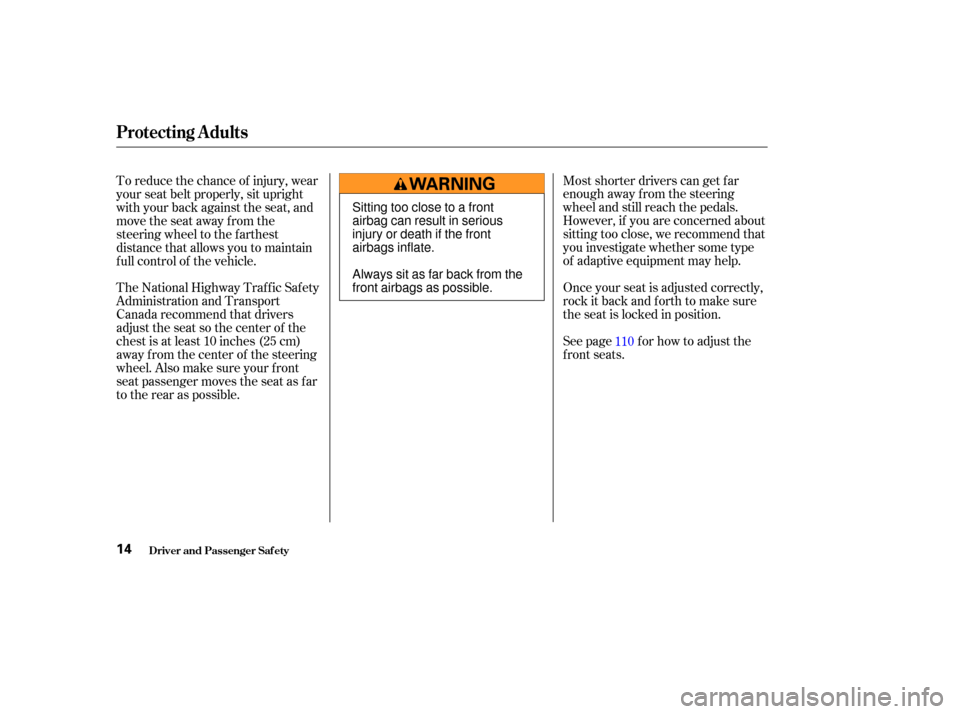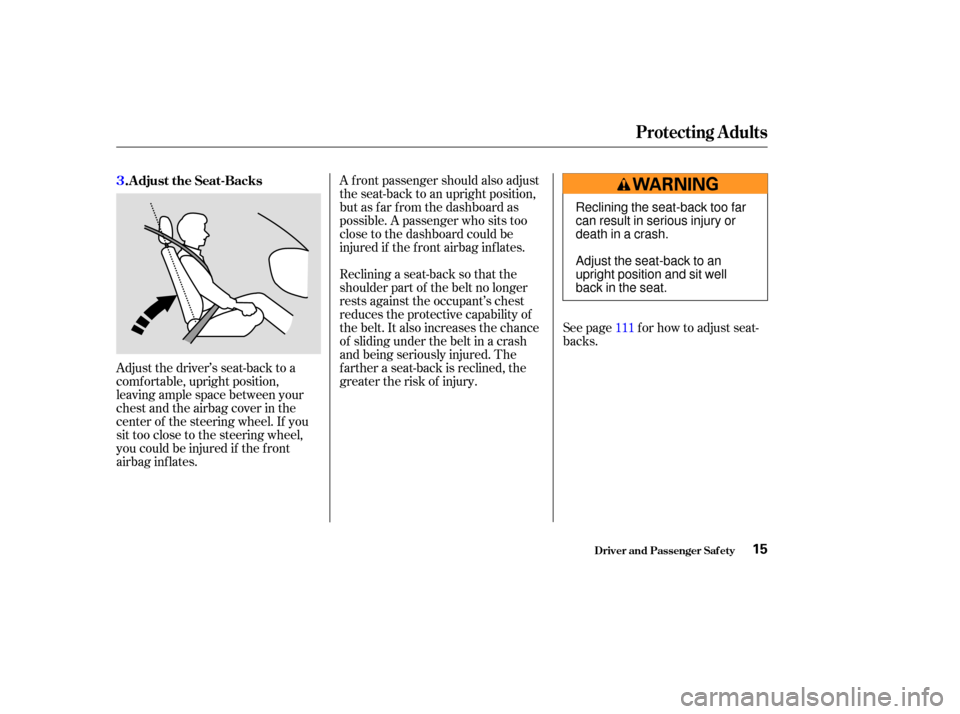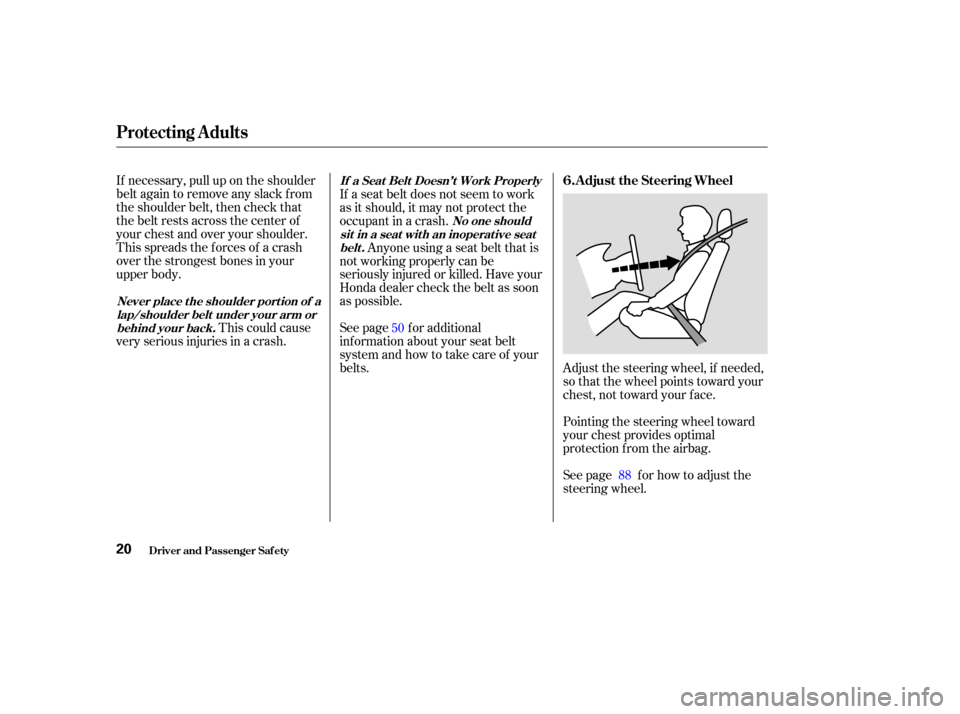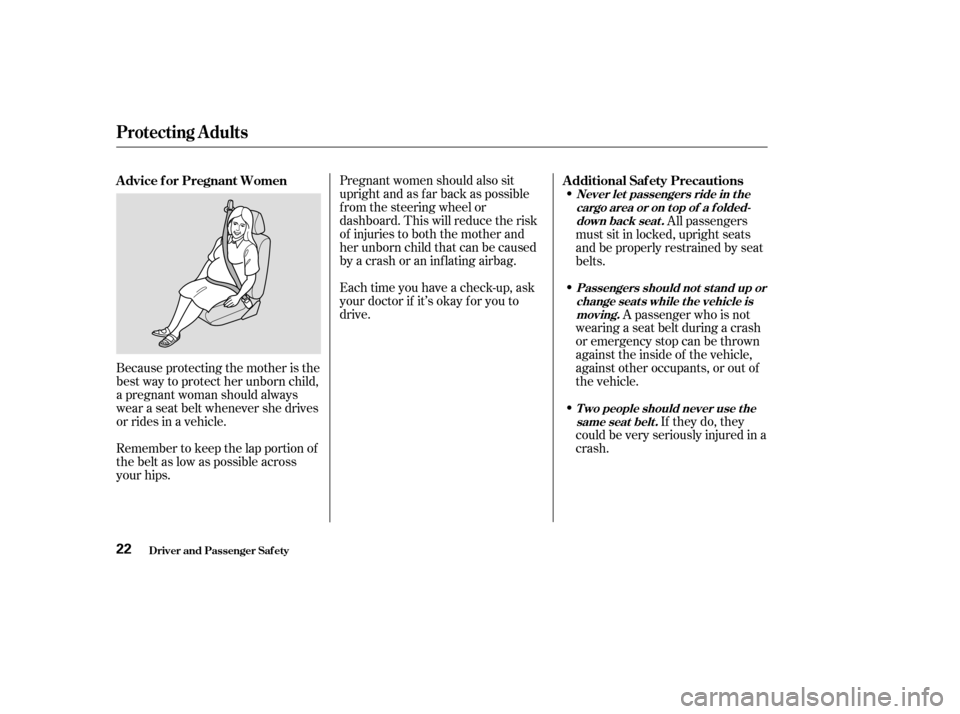2003 HONDA ODYSSEY steering
[x] Cancel search: steeringPage 17 of 415

See page f or how to adjust the
f ront seats. Once your seat is adjusted correctly,
rock it back and f orth to make sure
the seat is locked in position. Most shorter drivers can get f ar
enough away f rom the steering
wheel and still reach the pedals.
However, if you are concerned about
sitting too close, we recommend that
you investigate whether some type
of adaptive equipment may help.
The National Highway Traffic Safety
Administration and Transport
Canada recommend that drivers
adjust the seat so the center of the
chest is at least 10 inches (25 cm)
away f rom the center of the steering
wheel.Alsomakesureyourfront
seat passenger moves the seat as f ar
to the rear as possible. To reduce the chance of injury, wear
your seat belt properly, sit upright
with your back against the seat, and
movetheseatawayfromthe
steering wheel to the f arthest
distance that allows you to maintain
f ull control of the vehicle.
110
Protecting Adults
Driver and Passenger Saf ety14
Sitting too close to a front
airbag can result in serious
injury or death if the front
airbags inflate.
Always sit as far back from the
front airbags as possible.
Page 18 of 415

See page f or how to adjust seat-
backs.
A f ront passenger should also adjust
the seat-back to an upright position,
but as f ar f rom the dashboard as
possible. A passenger who sits too
close to the dashboard could be
injured if the f ront airbag inf lates.
Reclining a seat-back so that the
shoulder part of the belt no longer
rests against the occupant’s chest
reduces the protective capability of
the belt. It also increases the chance
of sliding under the belt in a crash
and being seriously injured. The
farther a seat-back is reclined, the
greater the risk of injury.
Adjust the driver’s seat-back to a
comf ortable, upright position,
leaving ample space between your
chest and the airbag cover in the
center of the steering wheel. If you
sit too close to the steering wheel,
you could be injured if the f ront
airbag inflates. 111
Adjust the Seat-Backs
3.
Protecting Adults
Driver and Passenger Saf ety15
Reclining the seat-back too far
can result in serious injury or
death in a crash.
Adjust the seat-back to an
upright position and sit well
back in the seat.
Page 23 of 415

If necessary, pull up on the shoulder
belt again to remove any slack from
the shoulder belt, then check that
the belt rests across the center of
your chest and over your shoulder.
This spreads the f orces of a crash
over the strongest bones in your
upper body.This could cause
very serious injuries in a crash. If a seat belt does not seem to work
as it should, it may not protect the
occupant in a crash.
Anyone using a seat belt that is
not working properly can be
seriously injured or killed. Have your
Honda dealer check the belt as soon
as possible.
See page f or additional
inf ormation about your seat belt
system and how to take care of your
belts. Adjust the steering wheel, if needed,
so that the wheel points toward your
chest, not toward your f ace.
Pointing the steering wheel toward
your chest provides optimal
protection f rom the airbag.
See page f or how to adjust the
steering wheel.
50
88
Protecting Adults
Driver and Passenger Saf ety
Never place t he shoulder port ion of alap/shoulder belt under your arm orbehind your back. If a Seat Belt Doesn’t Work Properly
No one should
sit in a seat wit h an inoperat ive seat belt.
A djust the Steering Wheel
6.
20
Page 25 of 415

Pregnant women should also sit
upright and as f ar back as possible
f rom the steering wheel or
dashboard. This will reduce the risk
of injuries to both the mother and
her unborn child that can be caused
by a crash or an inf lating airbag.
Each time you have a check-up, ask
your doctor if it’s okay f or you to
drive.
Because protecting the mother is the
best way to protect her unborn child,
a pregnant woman should always
wear a seat belt whenever she drives
or rides in a vehicle.
Remember to keep the lap portion of
the belt as low as possible across
your hips. All passengers
must sit in locked, upright seats
andbeproperlyrestrainedbyseat
belts.
A passenger who is not
wearing a seat belt during a crash
or emergency stop can be thrown
against the inside of the vehicle,
against other occupants, or out of
the vehicle.
If they do, they
could be very seriously injured in a
crash.
Advice f or Pregnant Women
Additional Saf ety Precautions
Protecting Adults
Driver and Passenger Saf ety
Never let passengers ride in t he
cargo area or on t op of a f olded-down back seat .
Passengers should not st and up orchange seats while the vehicle ismoving.
T wo people should never use t hesame seat belt .
22
Page 26 of 415

If your
hands or arms are close to the
airbag covers in the center of the
steering wheel and on top of the
dashboard, they could be injured if
the airbags inf late.
Devices intended to improve
occupant comf ort or reposition the
shoulder part of a seat belt can
severely compromise the
protective capability of the seat
belt and increase the chance of
serious injury in a crash.
Carrying hard or sharp
objects on your lap, or driving with
a pipe or other sharp object in
your mouth, can result in injuries
if your f ront airbag inf lates. If a side airbag
inflates,acupholderorotherhard
object attached on or near the
door could be propelled inside the
vehicle and hurt someone.
Any object
attached to or placed on the covers
marked ‘‘SRS AIRBAG,’’ in the
center of the steering wheel and
on top of the dashboard, could
interf ere with the proper operation
of the airbags. Or, if the airbags
inf late, the objects could be
propelled inside the car and hurt
someone. This could make the driver’s
seat position sensor or the f ront
passenger’s seat weight sensors
inef f ective.
This could
cause problems with the driver’s
seat position sensor or the f ront
passenger’s seat weight sensors.
Protecting Adults
Driver and Passenger Saf ety
K eep your hands and arms away
f rom t he airbag covers.
Do not put any accessories on seat
belts.
Do not place hard or sharp object sbet ween yourself and a f rontairbag. Do not at t ach hard object s on or
near a f ront door.
Do not at t ach or place object s on the f ront airbag covers. Do not modif y t he f ront seat s.
Do not place any it ems undert he f ront seat s.
23
Page 57 of 415

Your Supplemental Restraint System
(SRS) includes:Automatic seat belt tensioners
(see page ). Two f ront airbags. The driver’s
airbag is stored in the center of
the steering wheel; the f ront
passenger’sairbagisstoredinthe
dashboard. Both are marked ‘‘SRS
AIRBAG.’’
Sensors that can detect a
moderate to severe frontal
collision.
A sophisticated electronic system
that continually monitors and
records inf ormation about the
sensors, the control unit, the
airbag activators, and driver and
passenger seat belt use when the
ignition is ON (II). 52
SRS Components
Additional Inf ormation About Your Airbags
Driver and Passenger Saf ety54
(1) Driver’s Airbag
(2) Front Passenger’s Airbag
(3) Control Unit
(4) Seat Belt Tensioners
(5) Side Airbags
(6) Driver’s Seat Position Sensor
(7) Front Passenger’s Weight Sensors
(8) Front Sensor
(9) Passenger Airbag Cutoff Indicator
(5)
(9)
(2)
(8)
(3)
(7)
(4)
(4) (1)
(5)
(6)
(7)
Page 61 of 415

The driver’s and f ront passenger’s
seat sensors may not work properly
if :Be caref ul not to spill any liquids.
Spilled liquids could damage the
sensors under the f ront seats.
If your vehicle sustains a severe
impact, have the driver’s seat
position sensor and the f ront
passenger’s weight sensors
inspected by your Honda dealer.
You do not wear your seat belt
properly.
You do not sit upright and as f ar
back as possible f rom the steering
wheel or the dashboard (see page
).
You do not secure the child seat
properly, and move the f ront seat
as far back as possible. For additional information on how
your airbags work, see the booklet
titled
that came with your
owner’s manual.
For additional information on how
your airbags work, ask your dealer
f or a copy of the booklet titled
20
SRS: What You Need to Know
About Airbags
SRS:
What You Need to Know About Airbags
.
Driver and Passenger Saf ety
Additional Inf ormation About Your Airbags
U.S.Owners
Canadian Owners
58
Page 72 of 415

This section gives inf ormation about
the controls and displays that
contribute to the daily operation of
your Honda. All the essential
controls are within easy reach............................
Control Locations .70
...............................
Indicator Lights .71
.............................................
Gauges .78
Controls Near the Steering .......................................
Wheel .81
...................................
Headlights .82
Automatic Lighting Off .....................................
Feature .83
............
Daytime Running Lights . 83
....
Instrument Panel Brightness . 83
................................
Turn Signals .84 .....................
Windshield Wipers .84
..................
Windshield Washers . 86
Rear Window Wiper and .....................................
Washer .86
..........................
Hazard Warning .87
.............
Rear Window Def ogger . 87
......
Steering Wheel Adjustment . 88
...............................
Keys and Locks .89
..............................................
Keys .89
....................
Immobilizer System . 90
............................
Ignition Switch .91
......................
Power Door Locks .92
...................
Remote Transmitter . 94
..............
Childproof Door Locks . 98
........................................
Tailgate .98
..................................
Glove Box .100
...................
Manual Sliding Doors . 101
.....................
Power Sliding Doors .103
...............................................
Seats .109
....................
Passenger Seating .109
......................
Seat Adjustments .110
Driver’s Seat Manual Height ............................
Adjustment .112
Driver’s Seat Power ..........................
Adjustments .113
.........
Driver’s Lumbar Support . 114....................................
Armrests .115
........................
Head Restraints .115
.....................
Third Seat Access .116
Moving the Second Row ...........................
Bucket Seat .117
Removing the Bucket Seats ................
in the Second Row . 119
Folding the Third Row .........................
‘‘Magic Seat’’ .120
..................................
Seat Heaters .123
............................
Power Windows .124
...........................................
Mirrors .128
...............................
Parking Brake .129
..................................
Digital Clock .130
..................................
Center Table .130
.........................
Beverage Holders .132
........................
Sunglasses Holder .134
........................................
Sun Visor .134
................................
Vanity Mirror .135
.......................
Rear Compartment .135
...............................
Center Pocket .136
...................................
Coin Holder .136
...................................
Storage Box .137
......................................
Coat Hook .137
............
Accessory Power Sockets . 138
...............................
Interior Lights .139
Instruments and Controls
Inst rument s and Cont rols69